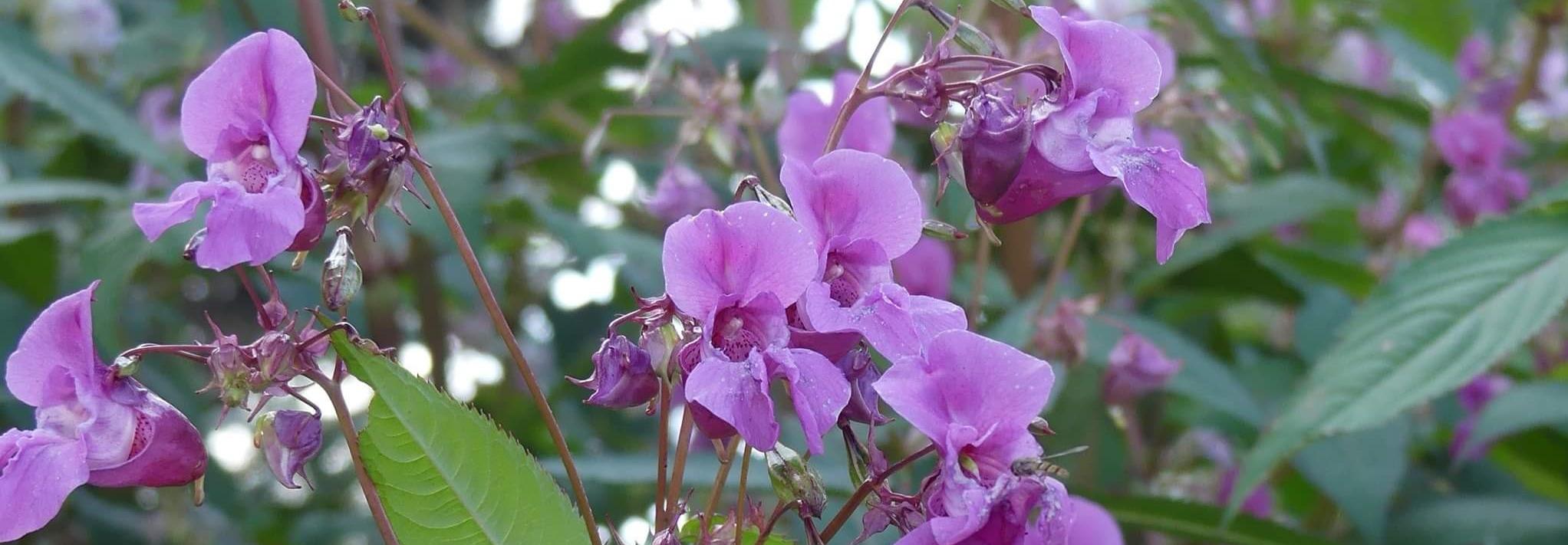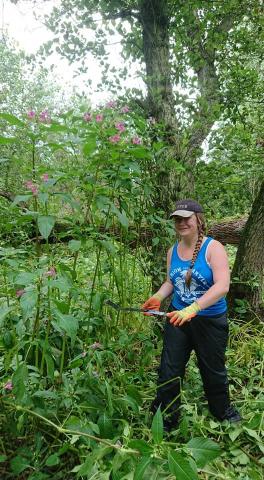
We’re delighted to have as our blogger this week, Elise Cox, a student with Inverness College UHI who writes about her experiences of tackling invasive plant species in a placement last summer.
"At first glance, one might be forgiven for thinking that this pretty little plant wasn’t a plague on the riverbanks of Scotland. There’s certainly no denying the visual appeal of Himalayan balsam — with it’s exotic-looking pink flowers that are almost reminiscent of tropical orchids — which would explain why it was introduced into Kew Gardens some two-hundred-and-fifty years ago. However, as we now know all too well, beneath an innocent exterior, the balsam hides its true colours as a master of invasion and colonisation.
Since its introduction to Victorian botanical gardens it has spread across the entirety of the British Isles using its superpower: explosive pods which can eject eight hundred seeds, seven metres in all directions. This, combined with its blisteringly rapid growth and preferred habitat of soft, damp banks of various watercourses, means that it isn’t an uncommon sight to see your favourite riverside walk become completely choked with great walls of flowering balsam, ready to spread and continue its tyrannical reign over our waterways.
Not only do infestations of these unassuming super-villains suffocate any native plants, but they can also compromise the integrity of the habitat they occupy. The balsam’s shallow roots and annual dieback mean increased bank erosion during the winter months, and dense stands of this leafy invader can occasionally clog the watercourses themselves and become a flood risk. Despite this, pollinators such as bees can be seen favouring this plant, which could lead to a knock-on effect for our native plants, which aren’t then pollinated as a result.
It seems like a hopeless case, but fear not dear reader, all is not lost! Just because balsam is widespread doesn’t mean it can’t be defeated with a few willing pairs of hands and the right tools. In fact, with proper effort and motivation, a small group of volunteers can clear large areas of these invasive plants in a relatively short period of time. This is where the volunteers of the Scottish Invasive Species Initiative (or SISI for short if you prefer less of a mouthful!) come in.
I was one such volunteer involved in what came to be known as the Great Balsam Bash of 2019. I had been working with SISI for most of the summer and had come up against a veritable rogues’ gallery of invasive plants. From the toxic giant hogweed to the creeping white butterbur, I thought I had seen it all, but au contraire. When I was picked up by SISI project officer James that overcast August morning, I had no idea what the day had in store for us. Of course, I had seen balsam before, but only in relatively small clumps. I was also used to working alone with James — as our usual jobs only required two or three motivated volunteers to complete — so imagine my surprise when not one but five extra volunteers arrived to meet us at the site.
I was soon to realise that their presence was a blessing, as all seven of us trooped over the bridge, up the path from the car park and the strength of our enemy’s numbers became starkly apparent. We were standing on a well-travelled footpath between the railway bridge and the road bridge in the heart of Nairn, with cars and people travelling passed constantly, which made an interesting change from the more remote areas that invasive plants usually make their strongholds. However, as I surveyed the busy scene, I realised that if my internal compass served me, there should also be a river somewhere in amongst it all; but there was no sign of it through the towering, tangled stems of balsam.
It was James’ aim to clear the entire area, upwards of two acres by his estimation, by the end of the day. A tall order, some may think, but not to be intimidated by our foes, we intrepid volunteers armed ourselves and prepared for battle. Our vanguard consisted of two brush-cutters which would spearhead our advance by clearing larger paths, while the rest of us made inroads elsewhere using weed-whackers. With the starting gun fired, we disappeared into the forest of stems, the largest of which loomed over little old me. However, one slice to the bottom of the stem with my trusty weed-whacker was enough to bring even the largest of my adversaries tumbling down.
Like Navy SEALs clad in wellie-boots we swept across the site and by the time we stopped for a tea break we had already made great progress. As we sheltered under the bridge like a crowd of trolls happily munching on biscuits, we surveyed our handiwork: much of the balsam field lay decimated, the ground carpeted with cut stems. Due to their high water content, it wouldn’t be long before they started to rot down, but until then they would provide some protection for the soft riverbank from washing away with the next heavy rain. Re-energised and determined, we emerged to enter back into the fray, cutting down the plants, which at this point would do well to tremble at the sight of us.
True to James’ target and as testament to what a group of us super-volunteers could achieve, the entire two-acre site was cleared and I could actually see the elusive river from the footpath once more. Of course, we’d need to keep an eye on the site in the next few weeks, just in case any stragglers decided to try any funny business, and the site would likely require similar treatment again due to balsam seeds remaining viable for up to two years, but with any luck we valiant volunteers had laid the groundwork for the recovery of native species in the area. Admittedly, it may take a few years for a full recuperation, but that’s the beauty of conservation: knowing that your hard work can make a long-term difference and that you’re ensuring that the environment can be enjoyed by everyone, human, plant and animal alike.
Unlike some of its more stubborn, or dangerous fellows, Himalayan balsam control is a great way to get involved in the conservation of our waterways. It can easily be uprooted by hand and is suitable for volunteers of all shapes and sizes: whether you’re an angler, a parent, or a dog-walker, you can help make a difference by pulling a few stems on your daily walk or even by organising a balsam bash of your own.
If you’re inspired to join the fight against invasive species and would like to volunteer with SISI, visit www.invasivespecies.scot to find out more, and perhaps I’ll see you out on the river soon!"
